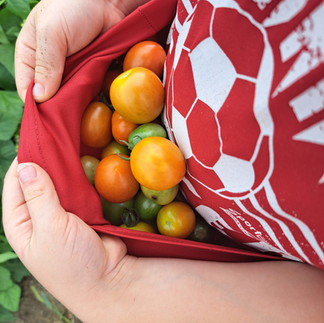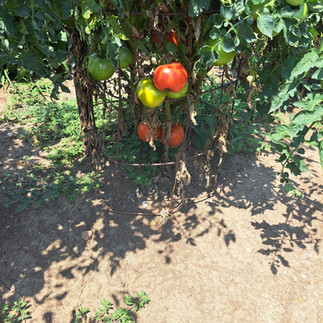Growing and Harvesting Tomatoes
- Kelsey

- Sep 26, 2023
- 2 min read

Did you know there are more than 10,000 varieties of tomatoes? From Celebrity to Jet Star, and Roma to Cherry, there are so many options to choose from!

Tomatoes are a rockstar vegetable...er, fruit. Whatever you want to categorize it as, just know you're consuming a wonderful source of vitamin C, potassium, and antioxidants. (Hello, lycopene!) Their versatility is so vast, you can add them to just about any dish you make. We love to can our own salsa, tomato sauce, and pasta sauce to preserve our harvest and enjoy all year long. Eating them fresh on salads, tacos, or BLT's are also amazing ways to get them into your meal plan!
You can start your tomato plants from seed, but we generally buy ours already started from a local greenhouse in our area. If the seed route is your jam, you'll want to begin about 4-6 weeks before your last frost date. This allows the plants time to go through germination and growth processes, enough to begin bearing fruit when the weather gets warmer.
To plant in your garden, you'll want to wait until low temperatures consistently stay above 50°F. Each year brings weather unpredictability and sometimes freeze threatening temperatures can sneak their way in after you've planted your Spring crop. Not to fear! As long as you cover the foliage with a milk jug or 5 gallon bucket at night, your little ones are sure to survive!

Depending on the type of tomato you plant, you'll want to keep them about 2 feet apart. We plant ours in a row 6 inches deep, removing all of the bottom few leaves before placing in the ground. Then, mound the dirt up around the bottom so the stem is study and upright. To be precise, simply research the tomato variety or follow the instructions on the tag if they came with one. Tomatoes are a vine crop, so they need plenty of room to grow. Ensure there is plenty of space between the tomatoes and other vegetables you may grow to maximize air flow. You can prune back any side shoots you'd like that don't have blooms on them, but we usually leave our plants alone to do their thing. (And they do just fine!)
Eventually, the tomato plant will get too heavy and fall over, and it will vine out and take over a ton of space. We add tomato cages over top of the plants to encourage them to grow upward, which is both a space saver and a back saver!!
Once tomatoes begin to turn from green to a yellow-orange/red color, they can be picked and stored indoors to continue to ripen. Something we have found that is common in those first few ripe tomatoes is rotting on the bottom. If you find any tomatoes that are red but have rot on the bottom and none of the tomato is salvageable, discard those tomatoes away from your garden spot. If they spoil in the soil, it could introduce more fungal diseases that encourage more rot in the future.

Check out one of our favorite ways to preserve tomatoes: tomato sauce!

















Comments